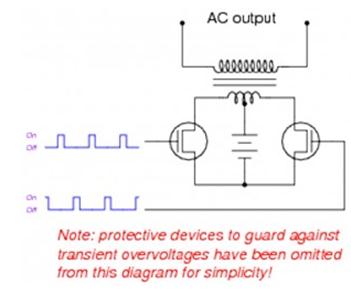What is an Inverter?
An inverter converts the DC voltage to an AC voltage. In most cases, the input DC voltage is usually lower while the output AC is equal to the grid supply voltage of either 120 volts, or 240 Volts depending on the country.
The inverter may be built as standalone equipment for applications such as solar power, or to work as a backup power supply from batteries which are charged separately.
An inverter provides an ac voltage from dc power sources and is useful in powering electronics and electrical equipment rated at the ac mains voltage. In addition they are widely used in the switched mode power supplies inverting stages. The circuits are classified according the switching technology and switch type, the waveform, the frequency and output waveform.
Basic inverter operation:
The basic circuits include an oscillator, control circuit, drive circuit for the power devices, switching devices, and a transformer.
The conversion of dc to alternating voltage is achieved by converting energy stored in the dc source such as the battery, or from a rectifier output, into an alternating voltage. This is done using switching devices which are continuously turned on and off, and then stepping up using the transformer. Although there are some configurations which do not use a transformer, these are not widely used.
A simple push pull DC to AC inverter with centre tap transformer circuit is a shown in the figure below.

Figure 1: basic inverter switching circuit
The DC input voltage is switched on and off by the power devices such as MOSFETs or power transistors and the pulses fed to the primary side of the transformer. The varying voltage in the primary induces an alternating voltage at secondary winding. The transformer also works as an amplifier where it increases the output voltage at a ratio determined by the turn’s ratio. In most cases the output voltage is raised from the standard 12 volts supplied by the batteries to either 120 Volts or 240 volts AC.
The three commonly used Inverter output stages are, a push-pull with centre tap transformer, push-pull half-bridge, or push-pull full bridge. The push pull with centre tap is most popular due to its simplicity and, guaranteed results; however, it uses a heavier transformer and has a lower efficiency.
EverExceed has more than a decade of experience in solar industry. Based on the vast knowledge, EverExceed select the best, high quality, high reliability products to manufacture solar systems. If you have any requirements or any kind of query regarding the EverExceed Inverter solution for your desired applications, feel free to communicate with our dedicated team at any time at marketing@everexceed.com.
Thể loại
gần đây bài đăng
quét vào wechat:everexceed
